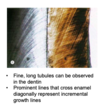11. Histology Of Nasal And Oral Cavities Flashcards
Ciliated columnar epithelial cells; contain Goblet cells; non-ciliated basal cells (stem cells)
Pseudostratified columnar ciliated epithelium

Rich, vascular network with a complex set of capillary loops
Lamina propria

What divides the nasal cavities?
Nasal septum

Three regions of the nasal cavities
(1) nasal vestibule, (2) respiratory region, (3) olfactory region

Located just inside nostrils and is lined by skin
Nasal vestibule
Inferior 2/3 of the nasal cavities and lined with respiratory mucosa
Respiratory region
Located at the apex (upper 1/3) and lined by specialized olfactory mucosa
Olfactory region
Function of the nasal cavities
Adjusts temperature and humidity of inspire air (enhanced by large SA of turbinates)
Air-filled spaces in bones of the walls of nasal cavity
Paranasal sinuses
Extensions of the respiratory region of the nasal cavity and lined by respiratory epithelium
Paranasal sinuses
How do paranasal sinuses communicate with nasal cavities?
Narrow openings onto the respiratory mucosa (mucus produced in sinuses is swept into nasal cavities by ciliary movements)
Clinical importance of paranasal sinuses
Often subject to acute infection after viral URI; severe cases may require physical drainage
Cell type in nasal vestibule
Keratinized stratified squamous epithelium

Cell type of respiratory region (posterior to vestibule)
Pseudostratified columnar ciliated epithelium

Characteristics of olfactory mucosa
Dramatically thicker, lacks goblet cells, thin BM

Cell type of olfactory mucosa
Pseudostratified ciliated columnar epithelium

Secretion of olfactory glands
Serous secretions that dissolve odorant molecules
Where are receptors for sense of smell found?
Olfactory mucosa

Describe olfactory receptor cells.
(1) have single dendritic process, (2) specialized non-motile cilia w/ odorant receptors, (3) ligand binding causes signals to be sent to olfactory bulb
Stem cells for olfactory receptor and supporting cells
Basal cells
Ciliated, columnar epithelial cells in contact with CN V
Brush cells
Proved mechanical and metabolic support to olfactory receptor cells
Supporting/sustentacular cells
Label.


Label.

Add







































